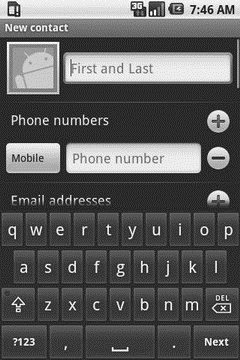Книга: Beginning Android
Squeezably Soft
Squeezably Soft
With the May 2009 debut of the HTC Magic, we now have Android phones lacking hardware keyboards. This makes text entry rather difficult… except that Android 1.5 added in support for soft keyboards. Soft keyboards also help for internationalization, as the user is not limited to the particulars of whatever hardware keyboard their device may actually have.
Soft keyboards take effect automatically, for basic functionality. The EditText widgets in your layout will cause the soft keyboard to spring up, assuming the device either does not have a QWERTY keyboard (e.g., HTC Magic) or is being held with the keyboard closed (e.g., T-Mobile G1 in portrait mode) as seen in Figure A-1.

Figure A-1. Android 1.5’s Input Method Editor (a.k.a., soft keyboard)
You can tailor the behavior of the soft keyboard in your layouts or via Java code. For example, in the screenshot shown previously, you will see a “Next” button in the lower-right corner. By default, Android will take a guess as what to use this “action button” for — in this case, it moves you to the next field. You can add attributes to your layout to control what the caption is for this button, and what actually occurs when the action button is tapped. So, for example, if you are allowing people to enter a URL to visit in a Web browser, you might rename the action button to “Go” and have it launch the Browser application upon the typed-in URL.
You can also provide light control over what sort of keyboard is displayed by indicating what sort of text entry is supposed to occur in the EditText. For example, you can indicate that the android:inputType is textEmailAddress, which will ensure an @ key is available without having to use a soft shift key.
You can also control what happens to your activity layout when the soft keyboard is displayed. Your activity can either scroll out of the way to support the keyboard, or it can be resized to accommodate the keyboard, or have the keyboard appear full-screen, eclipsing your activity until the text entry is complete. Android will attempt to determine the best answer automatically, but via the android:windowSoftInputMode on your <activity> element in your manifest, you can override the default behavior.
This Input Method Framework (IMF) is extensible, should you wish to create your own customized soft keyboard (a.k.a., input method editor, or IME) for use in your application or by other applications. A sample IME is provided with the SDK to serve as a basis for your own custom keyboards.
- Как уменьшить размер документа Microsoft Word?
- Интеграция Windows SharePoint и Microsoft Office
- 3.7 Система Microsoft Exchange 2000 и NAS
- 7.4 Технология виртуализации хранилища от компании Microsoft
- Продукты и технологии Microsoft SharePoint
- Извлечение и возврат документов в приложениях Microsoft Office 2007
- Создание рабочих областей для документов из приложений Microsoft Office 2007
- Часть III Пакет Microsoft Office
- Как в документ Microsoft Word вставить текст, в котором отсутствует форматирование?
- DiskExplorer от Runtime Software
- Я слышал, что в Microsoft Word можно играть в шахматы. Каким образом?
- Не всегда хочется, чтобы остальные пользователи знали, с какими документами я работал, однако Microsoft Word сохраняет и...




